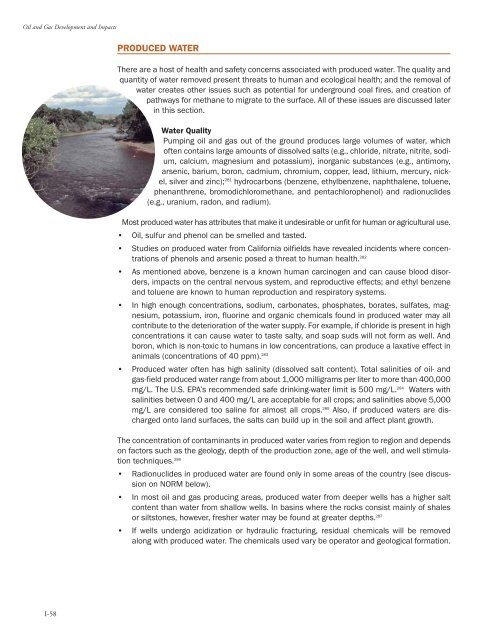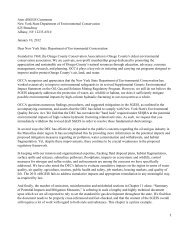Oil and Gas at Your Door? (2005 Edition) - Earthworks
Oil and Gas at Your Door? (2005 Edition) - Earthworks
Oil and Gas at Your Door? (2005 Edition) - Earthworks
Create successful ePaper yourself
Turn your PDF publications into a flip-book with our unique Google optimized e-Paper software.
<strong>Oil</strong> <strong>and</strong> <strong>Gas</strong> Development <strong>and</strong> Impacts<br />
PRODUCED WATER<br />
There are a host of health <strong>and</strong> safety concerns associ<strong>at</strong>ed with produced w<strong>at</strong>er. The quality <strong>and</strong><br />
quantity of w<strong>at</strong>er removed present thre<strong>at</strong>s to human <strong>and</strong> ecological health; <strong>and</strong> the removal of<br />
w<strong>at</strong>er cre<strong>at</strong>es other issues such as potential for underground coal fires, <strong>and</strong> cre<strong>at</strong>ion of<br />
p<strong>at</strong>hways for methane to migr<strong>at</strong>e to the surface. All of these issues are discussed l<strong>at</strong>er<br />
in this section.<br />
W<strong>at</strong>er Quality<br />
Pumping oil <strong>and</strong> gas out of the ground produces large volumes of w<strong>at</strong>er, which<br />
often contains large amounts of dissolved salts (e.g., chloride, nitr<strong>at</strong>e, nitrite, sodium,<br />
calcium, magnesium <strong>and</strong> potassium), inorganic substances (e.g., antimony,<br />
arsenic, barium, boron, cadmium, chromium, copper, lead, lithium, mercury, nickel,<br />
silver <strong>and</strong> zinc); 281 hydrocarbons (benzene, ethylbenzene, naphthalene, toluene,<br />
phenanthrene, bromodichloromethane, <strong>and</strong> pentachlorophenol) <strong>and</strong> radionuclides<br />
(e.g., uranium, radon, <strong>and</strong> radium).<br />
Most produced w<strong>at</strong>er has <strong>at</strong>tributes th<strong>at</strong> make it undesirable or unfit for human or agricultural use.<br />
• <strong>Oil</strong>, sulfur <strong>and</strong> phenol can be smelled <strong>and</strong> tasted.<br />
• Studies on produced w<strong>at</strong>er from California oilfields have revealed incidents where concentr<strong>at</strong>ions<br />
of phenols <strong>and</strong> arsenic posed a thre<strong>at</strong> to human health. 282<br />
• As mentioned above, benzene is a known human carcinogen <strong>and</strong> can cause blood disorders,<br />
impacts on the central nervous system, <strong>and</strong> reproductive effects; <strong>and</strong> ethyl benzene<br />
<strong>and</strong> toluene are known to human reproduction <strong>and</strong> respir<strong>at</strong>ory systems.<br />
• In high enough concentr<strong>at</strong>ions, sodium, carbon<strong>at</strong>es, phosph<strong>at</strong>es, bor<strong>at</strong>es, sulf<strong>at</strong>es, magnesium,<br />
potassium, iron, fluorine <strong>and</strong> organic chemicals found in produced w<strong>at</strong>er may all<br />
contribute to the deterior<strong>at</strong>ion of the w<strong>at</strong>er supply. For example, if chloride is present in high<br />
concentr<strong>at</strong>ions it can cause w<strong>at</strong>er to taste salty, <strong>and</strong> soap suds will not form as well. And<br />
boron, which is non-toxic to humans in low concentr<strong>at</strong>ions, can produce a lax<strong>at</strong>ive effect in<br />
animals (concentr<strong>at</strong>ions of 40 ppm). 283<br />
• Produced w<strong>at</strong>er often has high salinity (dissolved salt content). Total salinities of oil- <strong>and</strong><br />
gas-field produced w<strong>at</strong>er range from about 1,000 milligrams per liter to more than 400,000<br />
mg/L. The U.S. EPA’s recommended safe drinking-w<strong>at</strong>er limit is 500 mg/L. 284 W<strong>at</strong>ers with<br />
salinities between 0 <strong>and</strong> 400 mg/L are acceptable for all crops; <strong>and</strong> salinities above 5,000<br />
mg/L are considered too saline for almost all crops. 285 Also, if produced w<strong>at</strong>ers are discharged<br />
onto l<strong>and</strong> surfaces, the salts can build up in the soil <strong>and</strong> affect plant growth.<br />
The concentr<strong>at</strong>ion of contaminants in produced w<strong>at</strong>er varies from region to region <strong>and</strong> depends<br />
on factors such as the geology, depth of the production zone, age of the well, <strong>and</strong> well stimul<strong>at</strong>ion<br />
techniques. 286<br />
• Radionuclides in produced w<strong>at</strong>er are found only in some areas of the country (see discussion<br />
on NORM below).<br />
• In most oil <strong>and</strong> gas producing areas, produced w<strong>at</strong>er from deeper wells has a higher salt<br />
content than w<strong>at</strong>er from shallow wells. In basins where the rocks consist mainly of shales<br />
or siltstones, however, fresher w<strong>at</strong>er may be found <strong>at</strong> gre<strong>at</strong>er depths. 287<br />
• If wells undergo acidiz<strong>at</strong>ion or hydraulic fracturing, residual chemicals will be removed<br />
along with produced w<strong>at</strong>er. The chemicals used vary be oper<strong>at</strong>or <strong>and</strong> geological form<strong>at</strong>ion.<br />
I-58




